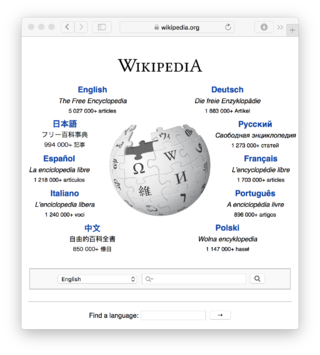
HyperText Markup Language or HTML is the standard markup language for documents designed to be displayed in a web browser. It defines the content and structure of web content. It is often assisted by technologies such as Cascading Style Sheets (CSS) and scripting languages such as JavaScript.

A markuplanguage is a text-encoding system which specifies the structure and formatting of a document and potentially the relationship between its parts. Markup can control the display of a document or enrich its content to facilitate automated processing.

A wiki is a form of online hypertext publication that is collaboratively edited and managed by its own audience directly through a web browser. A typical wiki contains multiple pages for the subjects or scope of the project, and could be either open to the public or limited to use within an organization for maintaining its internal knowledge base.

Wiki software is collaborative software that runs a wiki, which allows the users to create and collaboratively edit pages or entries via a web browser. A wiki system is usually a web application that runs on one or more web servers. The content, including previous revisions, is usually stored in either a file system or a database. Wikis are a type of web content management system, and the most commonly supported off-the-shelf software that web hosting facilities offer.
A lightweight markup language (LML), also termed a simple or humane markup language, is a markup language with simple, unobtrusive syntax. It is designed to be easy to write using any generic text editor and easy to read in its raw form. Lightweight markup languages are used in applications where it may be necessary to read the raw document as well as the final rendered output.
The following tables compare general and technical information for many wiki software packages.
Microformats (μF) are a set of defined HTML classes created to serve as consistent and descriptive metadata about an element, designating it as representing a certain type of data. They allow software to process the information reliably by having set classes refer to a specific type of data rather than being arbitrary.
Textile is a lightweight markup language that uses a text formatting syntax to convert plain text into structured HTML markup. Textile is used for writing articles, forum posts, readme documentation, and any other type of written content published online.
Notable issue tracking systems, including bug tracking systems, help desk and service desk issue tracking systems, as well as asset management systems, include the following. The comparison includes client-server application, distributed and hosted systems.
Object-Graph Navigation Language (OGNL) is an open-source Expression Language (EL) for Java, which, while using simpler expressions than the full range of those supported by the Java language, allows getting and setting properties, and execution of methods of Java classes. It also allows for simpler array manipulation.
Oracle WebCenter is Oracle's portfolio of user engagement software products built on top of the JSF-based Oracle Application Development Framework. There are three main products that make up the WebCenter portfolio, and they can be purchased together as a suite or individually:
Jira is a proprietary product developed by Atlassian that allows bug tracking, issue tracking and agile project management. Jira is used by a large number of clients and users globally for project, time, requirements, task, bug, change, code, test, release, sprint management.
Bitbucket is a Git-based source code repository hosting service owned by Atlassian. Bitbucket offers both commercial plans and free accounts with an unlimited number of private repositories.

Atlassian Corporation is an Australian-American software company that develops products for software developers, and project managers among other groups. The company is domiciled in Delaware, with global headquarters in Sydney, Australia, and US headquarters in San Francisco.
Crucible is a collaborative code review application by Australian software company Atlassian. Like other Atlassian products, Crucible is a Web-based application primarily aimed at enterprise, and certain features that enable peer review of a codebase may be considered enterprise social software.
SmartDraw is a web-based diagramming tool used by teams to collaborate on and make flowcharts, organization charts, mind maps, project charts, and other business visuals.
Pandoc is a free-software document converter, widely used as a writing tool and as a basis for publishing workflows. It was created by John MacFarlane, a philosophy professor at the University of California, Berkeley.
Gliffy is software for diagramming via an HTML5 cloud-based app. It is used to create UML diagrams, floor plans, Venn diagrams, flowcharts and various other kinds of diagrams online. Gliffy diagrams can be shared with and edited by users in real time. The SaaS is supported in all modern web-browsers, including Google Chrome, Firefox, Safari and Internet Explorer 9+.




